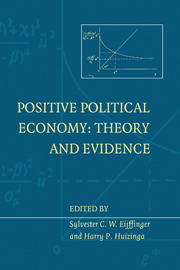Book contents
- Frontmatter
- Contents
- List of figures
- List of tables
- List of contributors
- Foreword
- Introduction
- I Monetary institutions and policy
- II Exchange rate policy and redistribution
- 7 Exchange rate anchors and inflation: a political economy approach
- 8 Why capital controls? Theory and evidence
- 9 The political economy of the Exchange Rate Mechanism
- 10 Unemployment benefits and redistributive taxation in the presence of labor quality externalities
- Index
8 - Why capital controls? Theory and evidence
from II - Exchange rate policy and redistribution
Published online by Cambridge University Press: 05 September 2013
- Frontmatter
- Contents
- List of figures
- List of tables
- List of contributors
- Foreword
- Introduction
- I Monetary institutions and policy
- II Exchange rate policy and redistribution
- 7 Exchange rate anchors and inflation: a political economy approach
- 8 Why capital controls? Theory and evidence
- 9 The political economy of the Exchange Rate Mechanism
- 10 Unemployment benefits and redistributive taxation in the presence of labor quality externalities
- Index
Summary
Introduction
The last decade has been characterized by a financial liberalization process that has led several industrialized and developing countries to dismantle or drastically reduce restrictions on international capital mobility. In the countries belonging to the European Monetary System, capital controls were gradually dismantled during the 1980s and abolished by 1990. In several developing countries, barriers to international capital movements are being reduced, as domestic investors are allowed to purchase foreign assets and non-residents to invest in domestic financial markets. The removal of restrictions to capital mobility was undertaken with the primary purpose of improving economic efficiency through better resource allocation and a more efficient functioning of financial markets. The liberalization of capital flows would also allow domestic investors to better hedge against macroeconomic risks through international portfolio diversification. The process of financial liberalization was further stimulated by the realization that the technological progress in telecommunications together with the growing integration of financial markets made it more difficult for authorities to effectively monitor capital flows.
Two recent developments, however, have contributed to give prominence once again to the debate on the usefulness of restrictions on international capital flows. The first is the series of speculative attacks on currencies belonging to the European Monetary System and to the European Free Trade Area, beginning in September 1992, that brought abruptly to an end a period of exchange rate stability in Europe.
- Type
- Chapter
- Information
- Positive Political EconomyTheory and Evidence, pp. 217 - 247Publisher: Cambridge University PressPrint publication year: 1998
- 12
- Cited by



